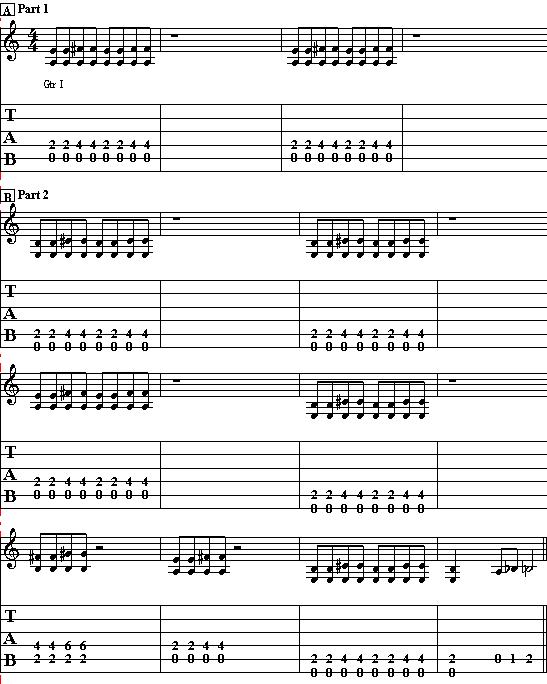Hi everybody. This is Darrin Goodman from guitarcontrol.com
bringing you this video lesson today. Today I want to give
you a little lesson on switching off between rhythm and lead
in kind of a blues context. Be sure to click on the link in
the description for the tabs.
What I’m doing here today is just your basic shuffle
rhythm in A. I’ve got my 1st finger on the 2nd fret of
the 4th string and I’m playing that and the 5th string
open. Then I’m taking my 3rd finger and going to the
4th fret of the 4th string. So I’m playing this as 1/8
notes: one-and, two-and, three-and, four-and. Just your
basic, garden variety shuffle rhythm and it doesn’t even
actually have to be exactly that. You can kind of just
do whatever you want or what you already know how to do.
What I’m going to do is I’m going to play a full measure
of that and then I’m going to switch to playing just some
random minor pentatonic licks in A minor pentatonic and I’m
going to be using the first pattern. So on the 5th fret of
the 6th string we’ve got 5, 8, 5, 7, 5, 7, 5, 7, 5, 8, 5, 8.
We’re going to be playing this with a metronome today so that
way you can keep track of the beats that you’re playing. I
have it set today at 88 beats per minute. So I’m going to go
ahead and turn that on. Hopefully you can hear that well.
I’m just going to start off with that basic shuffle rhythm.
Just like that. I’m going to play four clicks, so four quarter
notes, a whole major of that rhythm and then I’m going to
switch to playing some select notes out of the A minor pentatonic
scale. I want it to last the same amount of time. So I’m going
to do it so it is also four clicks, an entire major of that.
So here we go.
So as you can see this is very beneficial to being able to
switch between the lead and the rhythm because that’s what
a lot of times happens in these blues things like this.
You can take this one step further and play it as a 12-bar
progression. So if we were going to do a 12-bar, I IV V
progression. So if we were going to do the same thing as a
shuffle, we would just move that same chord shape we did,
we’d move it down to the 6th and the 5th string so you’d
have That’s the I chord. When you go to the IV chord you
would switch to the A, then you would go back to the I chord
again. Then you would switch to a B, which is your V chord.
What I’m doing is the 2nd fret of the 5th string with my 1st
finger and then 4th fret of the 4th string with my 2nd finger
and then I’m going to do that same, lifting my finger up and
down, shuffle, alternating between the 6th and the 4th fret of
the 4th string. And then back to the IV chord, A and then back
to the I chord of E.
So you can do kind of that same concept with this. A
traditional 12-bar I IV V, you’ve got 4 bars of the I
chord, 2 bars of the IV chord, 2 bars of the I chord, a
bar of the V, a bar of the IV and then two bars of the I,
or a turnaround, but we’re not going to get into that today.
We’re going to work on this and what I’m going to do is
when I’m playing over the E I’m going to play in E, when
I’m playing over the A I’m going to play in A, play over
the B I’m going to play in B. I’m just going to use that
same scale that I showed you before. So when you’re doing
it in A you’re doing it here at the 5th fret. When you’re
doing it in B you’re starting on the 7th fret. When you’re
doing it in E you can either do it down here starting on the
12th fret or you can do it with using the open strings. That
scale pattern with the open strings is open, 2; open, 2; open,
2; open, 2; open, 3; open 3. I’m going to turn the metronome
on and we’ll give this a try.
When you first start practicing doing this you may have to
have the metronome tuned down to a little bit lower of a
tempo, but work your way up. I mean, it doesn’t need to
be lightening fast. It’s the blues. It’s quality; not
quantity as far as notes and stuff. But anyhow, this will
help you with getting the switch between playing the rhythm
or playing the lead. After you get good at it you can do it
and stay in time without the metronome when you’re playing
by yourself or jamming with your friends or whatever and
it’s a really great way to play it and it’s a lot of fun.
I hope you enjoyed that. Be sure to click on the link in
the description for the tabs. The tabs will have just that
rhythm section and then just use all the blues licks and
rock licks that you already have or make them up as you go
along. Until next time






